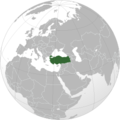Knowledge fuels change
For over a decade, Energypedia has shared free, reliable energy expertise with the world.
We’re now facing a serious funding gap.
Help keep this platform alive — your donation, big or small, truly matters!
Thank you for your support
Turkey Energy Situation
Capital:
Ankara
Region:
Coordinates:
39.9167° N, 32.8333° E
Total Area (km²): It includes a country's total area, including areas under inland bodies of water and some coastal waterways.
XML error: Mismatched tag at line 6.
Population: It is based on the de facto definition of population, which counts all residents regardless of legal status or citizenship--except for refugees not permanently settled in the country of asylum, who are generally considered part of the population of their country of origin.
XML error: Mismatched tag at line 6. ()
Rural Population (% of total population): It refers to people living in rural areas as defined by national statistical offices. It is calculated as the difference between total population and urban population.
XML error: Mismatched tag at line 6. ()
GDP (current US$): It is the sum of gross value added by all resident producers in the economy plus any product taxes and minus any subsidies not included in the value of the products. It is calculated without making deductions for depreciation of fabricated assets or for depletion and degradation of natural resources.
XML error: Mismatched tag at line 6.2 ()
GDP Per Capita (current US$): It is gross domestic product divided by midyear population
XML error: Mismatched tag at line 6. ()
Access to Electricity (% of population): It is the percentage of population with access to electricity.
XML error: Mismatched tag at line 6.no data
Energy Imports Net (% of energy use): It is estimated as energy use less production, both measured in oil equivalents. A negative value indicates that the country is a net exporter. Energy use refers to use of primary energy before transformation to other end-use fuels, which is equal to indigenous production plus imports and stock changes, minus exports and fuels supplied to ships and aircraft engaged in international transport.
XML error: Mismatched tag at line 6.no data
Fossil Fuel Energy Consumption (% of total): It comprises coal, oil, petroleum, and natural gas products.
XML error: Mismatched tag at line 6.no data
Introduction [1]
Secure energy supply remains essential also for Turkey. In this context, significant progress has been made recently in legal and technical terms which include restructuring Turkey's energy market on a competitive transparent basis, identifying and utilizing our domestic and renewable resource potentials, making nuclear energy a part of electricity production, and making use of energy efficiency and new energy technologies.
Between 1990 and 2008 in our country, annual average rate of increase in primary energy demand was realized as 4,3%. Among other OECD countries, Turkey has had the highest rate of energy demand increase of the past 10 years. Similarly, since 2000, Turkey has been the second largest economy after China for having the highest rate of increase in electricity and gas demand. Projections by our Ministry show that this trend will continue in the medium run.
In 2008, total primary energy consumption of Turkey was realized as 106,3 million Tons Equivalent of Petroleum (TEP), while production was at 29,2 million TEP. Of total energy supply, gas comes first (32%) which is followed up by petrol (29,9%), coal (29,5%), and renewable energy sources including hydraulic (8,6%). Based on the reference scenario, our primary energy consumption is expected to increase by 4% annually by 2020.
Energy Situation
[Show/hide]
Renewable Energy Sources
Solar Energy [1]
Having a high potential for solar energy due to its geographical position, Turkey's average annual total sunshine duration is calculated as 2.640 hours (daily total is 7,2 hours), and average total radiation pressure as 1.311 kWh/m²-year (daily total is 3,6 kWh/m²). Solar energy potential is calculated as 380 billion kWh/year.
With the decrease in the cost of using solar cells and increase in their efficiency, solar cell dependent energy generation is expected to increase in Turkey. Furthermore, using Turkey Solar Energy Potential Atlas and the CSP technology, it is calculated that an annual production of 380 billion kWh is possible.
The amount of solar collectors installed in Turkey is roughly 12 million m² with a technical solar energy potential of 76 TEP and annual generation volume is 750.000 m², part of which is exported. Such amount indicates that 0,15 m² of solar collectors are used per capita. Annual amount of solar-based heat generation is around 420.000 TEP. This data suggests that Turkey is a significant manufacturer and user of solar collectors among world countries.
Wind Energy [1]
According to Wind Energy Potential Atlas (REPA), which was realized in 2007, it is calculated that Turkey has a minimum wind energy potential of 5.000 MW in regions with annual wind speed of 8,5 m/s and higher and 48.000 MW with wind speed higher than 7,0 m/s.
Progress has been made in efforts for increasing installed wind energy power, which was at the level of a mere 18 MW as of 2004. Turkey's installed power for wind energy reached the level of 802,8 MW as of the end of 2009. Upon taking effect of the Renewable Energy Law, licenses were granted to 93 new wind projects which deliver a total installed power of 3.363 MW. Out of these projects, powers plants which correspond to an installed power of 1.100 MW are presently under construction.
Outlook of domestic wind energy potential as of 2008:
|
Type of Source |
Domestic Potential |
|
Wind |
Very Efficient: 8.000 MW |
|
Moderately Efficient: 40.000 MW |
Biofuel [1]
Electricity from Waste in Turkey. DW World film "Ideas for a cooler world" about a recycling and waste treatment center in Adana. For Further information please cllick here
Having a total fuel-oil consumption of 22 million tons, 3 million tons of which is benzene, Turkey has an installed bio-ethanol capacity of 160 thousand tons.
Reserving of arable lands for biodiesel and bio-ethanol production, which poses a global threat against food security, is the strongest criticism against bio-fuel oriented agriculture.
Biogas is mainly methane and carbon dioxide gas which is a product of biological decomposition (of animal wastes, vegetable wastes, urban and industrial wastes) under anaerobic conditions (i.e. anaerobic fermentation). Biogas technology allows us both to obtain energy from organic wastes, and also to bring wastes back into the soil.
Our biomass sources include agriculture, forests, animals, organic urban waste, etc. While our waste potential is around 8,6 MTEP, 6 MTEP is used for heating. In 2008, the total amount energy obtained from biomass sources was 66 thousand TEP.
Hydro Power [1]
Turkey's technically feasible hydroelectric potential is 140 GWh/year. 150 hydroelectric power plants (HEPP) that are presently in operation since the end of 2009 correspond to an installed power of 14.417 MW and 38% of the total potential.
18,5% of electricity generated in 2009 came from hydroelectric power plants. Recent draughts have substantially limited the contribution of hydroelectric power plants to electricity generation. Compared to 2008 however, hydroelectric production increased by 7,8% in 2009, reaching 35.870 MW.
Turkey aims at utilizing in electricity generation all hydroelectric potential that is technically and economically viable by the year 2023.
Geothermal Heating [1]
The first 5 world countries in geothermal heating and spa practices are China, Japan, USA, Iceland and Turkey.
Since Turkey is located on the Alpine-Himalayan belt, it holds a substantially high geothermal potential. Geothermal potential of our country is 31.500 MW. Areas with potential are concentrated in Western Anatolia (77,9%). By this day, 13% of said potential (4.000 MW) has been made available by MTA General Directorate of our Ministry.
55% of the geothermal areas in Turkey are suitable for heating practices. In Turkey, 1200 decares of greenhouses are heated using geothermal energy, and 100.000 households in 15 settlements are also heated with geothermal energy.
Prospecting for geothermal energy was revived recently, and starting from 2003, prospecting works by MTA General Directorate of Republic of Turkey Ministry of Energy yielded to a geothermal energy source of 840 MW.
While 1.500 MW of our geothermal energy potential is assessed to be suitable for electricity generation, finalized data is so far 600 MW. As of the end of 2009, our installed power of geothermal energy reached around 77,2 MW.
Nonrenewable Energy Sources
[Show/hide]
Coal [1]
At world scale, Turkey is a middle-level country in terms of lignite reserves and production amounts, and lower-level in hard coal. Having about 1,6% of world's total lignite reserves, Turkey's total lignite reserve is at 12,4 billion tons. Yet exploitable reserves are at 3,9 billion tons. Furthermore, having a low heating value, majority of our lignite is typically used at thermal power plants. Turkey's lignite reserves, around 46% is in Afsin-Elbistan basin. The most important hard coal reserves of our country are in Zonguldak and its vicinity. The total hard coal reserve in Zonguldak Basin is 1,322 billion tons, while visible reserve here is at the level of 519 million tons.
Lignite fields are spread across all regions of our country, and the heating values of the lignite coal in these fields vary between 1000 and 5000 kcal/kg. About 68% the total lignite reserves in our country being of low calorie type, 23,5% is between 2000-3000 kcal/kg, 5,1% between 3000-4000 kcal/kg, and 3,4% above 4000 kcal/kg.
In energy consumption, coal has a significant share of 28%.
Of the 33 million tons of coal sold in 2008, 82% went to thermal power plants, and 12% went to heating and industry. As of the end of 2008, installed power of lignite-based thermal power plants in our country is 8.205 MW, which corresponds to 19,6% of Turkey's total installed power. Contribution of coal to total installed power is 10.191 MW, which corresponds to 24% of our total installed power. Installed power of our hard coal based thermal power plants is 335 MW, which corresponds to 0,8% of our total installed power.
In order to meet the energy demand, which increased starting from 2005 in response to industrialization and population increase in the context of prioritizing domestic resources in energy production and reducing external dependency, efforts for discovering new coal fields and improving existing ones have gained impetus. In coal prospecting, the number of probes increased five folds within the last five years, which prospecting work yielded as of May 2008 to new lignite reserves of 4,1 billion tons in addition to the existing reserves of 8,3 billion tons.
Out of total electricity energy produced by the end of August 2009, around 29% was from imported and domestic coal. Out of coal fired electricity production by the end of August, 27% comes hard coal and imported coal, while 73% comes from domestic lignite coal.
Distribution of newfound lignite reserves by regions, as of May 2008:
|
Lignite Reserve Regions in Turkey |
Reserve Amount |
|
Afsin-Elbistan* |
1.915 million tons |
|
Elbistan* |
420 million tons |
|
Konya-Karapinar |
1.280 million tons |
|
Thrace |
498 million tons |
|
Manisa-Soma-Eynez |
170 million tons |
|
Eskişehir-Alpu |
275 million tons |
In order to bring domestic sources of coal into economy, under initiatives for conditionally transferring to private sector those coal fields that are under responsibility of the TKI General Directorate for building power plants, 8 fields were opened to private sector within the royalty model for building thermal power plants with a total installed power of 1.800 MW.
Within a six-year period (2003-2009), TKI dispensed a total of 9,2 million tons of coal to poor families.
Petroleum [1]
Due to its geopolitical position, Turkey is neighbors with countries that own three fourth of world's proven petroleum and natural gas reserves, and takes part and supports numerous important projects acting as an "Energy Corridor" between the energy-rich Caspian, Central Asian and Middle Eastern countries and consumer markets in Europe.
Turkey's oldest pipeline is the Iraq-Turkey Raw Petroleum Pipeline, which carries Kirkuk petroleum in Northern Iraq to the Western world. The amount of raw petroleum carried by this line reached 305 million barrels in 1999, which figure went down to 10.9 million barrels in 2006 because of sabotage and the unrest in Kirkuk. In 2009, this line carried 23,3 million tons of raw petroleum (corresponding to 165 barrels). Another pipeline carrying petroleum is the Baku-Tbilisi-Ceyhan (BTC) Raw Petroleum Pipeline which was commissioned on May 28, 2006. On 22 June 2008, transmission capacity of the line reached 1 million barrels per day. Attempts to make this pipeline operate at a higher capacity turned out to be successful reaching a daily capacity of 1,2 million barrels in 2009.
As of the end of 2009, Turkish petroleum reserves are 44,3 million tons, 2008 production is 2,2 million tones, and 2008 consumption is 27,8 million tons. 2009 production was realized as 2,4 million tons. Raw petroleum production from the beginning of petroleum prospecting activities in our country until the end of 2009 is 132,5 million tons.
As of the end of 2008, the installed power of our thermal power plants depending on petroleum and petroleum products is 2.300 MW, and such value corresponds to 5,5% of our total installed power. In 2008, petroleum based thermal power plants produced 7.519 GWh electricity energy.
From the beginning of petroleum prospecting activities in Turkey until the end of 2009, a total of 1.424 prospecting pits and 1.808 production, injection and development pits were opened, and 23 large and small natural gas fields and 102 petroleum fields were discovered.
Since 2002, importance and priority is given to domestic and foreign petroleum prospection and production activities of Turkish Petroleum Corporation (TPAO). Consequently, TPAO's prospecting and production budget was increased seven folds in 2002-2007 period, reaching 1 billion US Dollars as of 2008.
Natural Gas [1]
As of the end of 2009, Turkey's remaining exploitable natural gas reserve is 6,2 billion m³. Turkey's installed power in natural gas is 14.576 MW, which corresponds to 32,7% of our total installed power.
According to studies on natural gas supply-demand balance, there is no problem until 2011 to meet the annual gas demand. But during winter months, when demand is high, disruptions in source or route countries may create seasonal imbalances of supply and demand. In this context, commissioning in 2007 of Silivri natural gas depot, which has a capacity of 1,6 billion m³, has been very beneficial for ensuring availability of seasonal supply. Moreover, attempts continue to complete the Project on Building Additional Underground Depots in Salt Lake. The Baku-Tbilisi-Erzurum (BTE) Natural Gas Pipeline (Shah Sea Project), which aims at carrying Caspian gas resources to our country and European markets, has been commissioned. Gas transmission started on November 26, 2006, and first production of the Shah Sea Project started on December 15, 2006. Also the process of creating trans-Caspian petroleum and gas pipelines, in the context of Turkmen and Kazak resources, is being planned in a way that is integrated with other projects.
In 2007, Greece connection of the South European Gas Ring (Turkey-Greece-Italy Pipeline), which aims at transmitting Caspian and Middle Eastern gas resources to EU markets, was completed and commissioned. Italian connection is due for completion in 2012.
Electricity [1]
[Show/hide]
Having been realized as 198,1 billion kilowatt hour (kWh) in 2008, Turkey's gross electricity consumption decreased by 2,42%, regressing to 193,3 billion kWh in 2009. Compared to the previous year (198,4 billion kWh), Turkey's electricity generation also decreased this year by 2,02%, regressing to 194,1 billion kWh. Turkey's electricity generation is expected by 2020 to reach 499 terawatt hout (TWh) with an annual increase of around 8% according to the higher demand scenario, or 406 TWh with an annual increase of 6,1% according to the lower demand scenario. As of 21 July 2010, our installed power has now reached 46.126 MW after the deployment of a new power plant of 1.479 megawatt (MW).
In 2009, our electricity generation came from three main sources: natural gas by 48,6%, coal by 28,3%, hydroelectric by 18,5%, liquid fuels by 3,4%, and renewable resources by 1,1%. As of the end of 2009, out of Turkey's total installed power 54,2% is in Electric Generation Company (EÜAŞ), 16,4% in production companies, 13,7% in build-operate power plants, 8,1% in autoproducers, 5,5% in build-operate-transfer power plants, 1,5% in transferred power plants, and 0,6% in mobile power plants.
In line with the target of liberating the electricity market, Law No. 4628 provided for new production investments by private sector. From 2002 to 2009, Turkey's installed power capacity went up from 31.750 MW to 44.600 MW. An additional capacity of 12.850 MW was deployed during that period, around 7000 MW of which is generated by the privately invested power plants. In 2009, a new power plant of 3.002 MW was introduced to the system. 2.810 MW of the additional capacity deployed is generated by the privately invested power plants. These initiatives aim at creating a transparent and competition-driven market in the electricity sector, and thus to help improve the investment environment.
In 2010 (as of July 21, 2010), 64 privately owned power plants, which have a total installed power of 1479 MW, were temporarily accepted and licensed by our Ministry for operation. Of all the power plants deployed,
- 2% is geothermal (17 MW)
- 13% is wind power (330 MW)
- 29% is hydraulic (486 MW)
- 2% is landfill gas and bio-gas (7 MW)
- 18% is thermal (639)
60 MW of the thermal power comes from cogeneration power plants. By the end of this year, privately owned installed power, which is introduced in 2010, is expected to exceed 2400 MW.
- Policy Framework, Laws and Regulations [1]
- With a view to meet the high increase in demand, make sufficient investments, and increase economic efficiency, a new initiative was started after 2000 for structuring the energy sector around the central element of competition.
Policy Framework, Laws and Regulations
[Show/hide]
General Energy Policy, Energy Strategy[2]
Turkey's energy sector, which hitherto stood on three main pillars (natural gas, coal and hydraulic), is being redesigned in a sound, five-pillar structure to additionally include renewable resources and nuclear energy.
Turkey's energy policy principally aims at:
- Making energy available for the consumers in terms of cost, time and amount,
- Exploiting public an private facilities within the framework of free market practices,
- Discouraging import dependency,
- Securing a strong position for our country in regional and global trade of energy,
- Ensuring the availability of diversified resources, routes and technologies
- Ensuring maximum use of renewable resources,
- Increasing energy efficiency,
- Minimizing negative environmental impact while producing and using energy and natural resources.
Important Laws and Regulations
Following legislation were passed in respective chronology,
- Electricity Market Law (2001)
- Natural Gas Market Law (2001)
- Petroleum Market Law (2003)
- LPG Market Law (2005)
- Law on Utilization of Renewable Energy Resources for the Purpose of Generating Electrical Energy (2005)
- Energy Efficiency Law (2007)
- Law on Geothermal Resources and Mineral Waters (2007)
- Law on Construction and Operation of Nuclear Power Plants and Energy Sale (2007). This Law also introduced regulations regarding the utilization of domestic coal resources for the purpose of generating electrical energy, encouraging the establishment domestic coal fired thermal power plants.
- Law (2008) on the Amendment of Electricity Market Law No. 5784 on Supply Security and Certain Other Laws.
Specific Strategies (Biomass, renewable energies, rural electrification, energy access strategy etc.)
- Republic of Turkey Ministry of Energy and Natural Resources Strategic (2012-2014)
- Electricity Energy Market and Supply Security Strategy Paper (2009)
- Electricity Sector Reform and Privatication Strategy Paper (2004)
- Climate Change Strategy Document of Turkey (2010) Affairs
- Energy Strategy (Ocak 2009).pdf Turkey's Energy Strategy by Republic of Turkey Ministry of Foreign Affairs (2009)
Institutional Set Up In The Energy Sector
[Show/hide]
Governmental institutions Private sector (enterprises, NGOs) [1]
Republic of Turkey Ministry of Energy and Natural Resources collaborate with the below institutions:
- General Directorate of Mineral Research & Exploration (MTA)
- Turkish Atomic Energy Authority (TAEK)Turkish Electricity Transmission Company (TEİAŞ)
- General Directorate of Electricity Generation Corporation (EÜAŞ)
- Turkish Electricity Trading and Contracting Company Inc. (TETAŞ)
- General Directorate of Turkish Coal Enterprises (TKİ)
- Turkish Petroleum Corporation (TPAO)
- Petroleum Pipeline Corporation (BOTAŞ)
- Eti Mine Works General Management (ETİ MADEN)
- General Directorate of the Turkish Hard Coal Enterprises (TTK)
- Turkish Electromechanics Industry (TEMSAN)
- National Boron Research Institute (BOREN)
- Energy Market Regularty Authority (EPDK)
Activities of Other Donors and NGOs
[Show/hide]
- GIZ implements projects in Turkey on behalf of the German Federal Ministry for Economic Cooperation and Development (BMZ) and the Federal Ministry for Environment, Nature Conservation and Nuclear Safety (BMU).
- World Bank supports Turkey in the Energy Field.
Existing Projects
[Show/hide]
- GIZ- Resource-Efficient and Climate-Friendly Use of Animal Waste for Biogas Production in Turkey (Turkish-German biogas project)
- World Bank- Private Sector Renewable Energy and Energy Efficiency Additional Financing
- World Bank- Energy Community of South East Europe APL6 Project - Turkey
- World Bank Private Sector Renewable Energy and Energy Efficiency Project
- World Bank- Electricity Distribution Rehabilitation Project
- World Bank- Gas Sector Development
- World Bank- EGY.SEC LOAN -B LOAN
Further Information
[Show/hide]
References
[Show/hide]





















